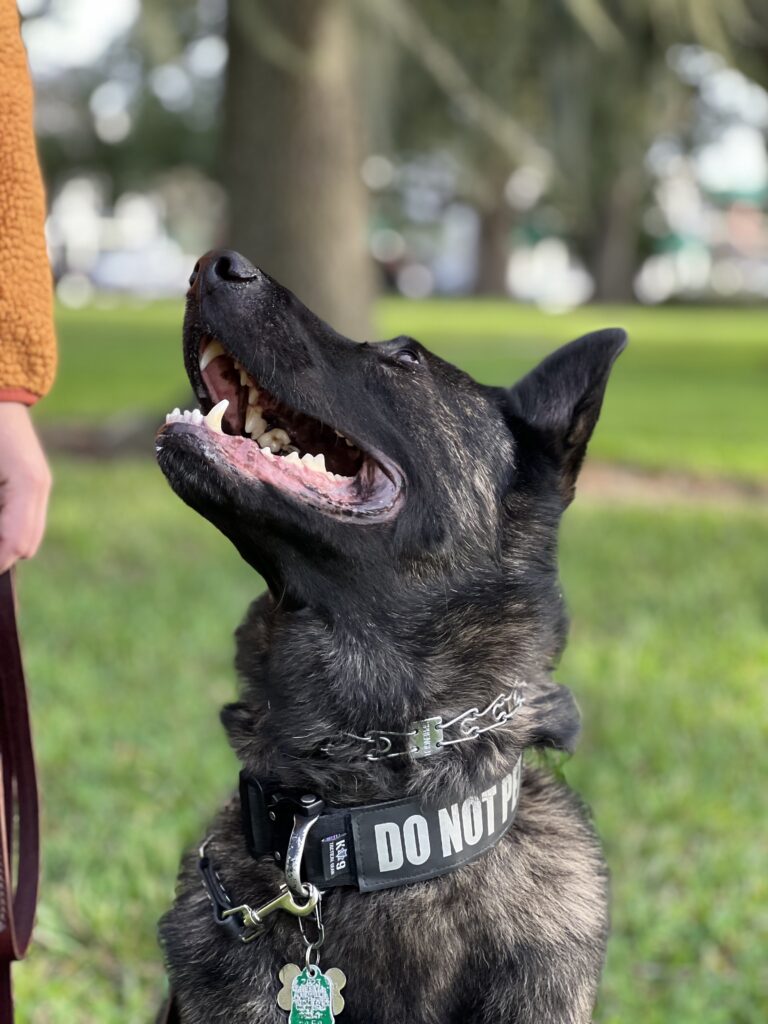In recent years, therapy dogs and service dogs have become increasingly visible in our communities. While both play crucial roles in enhancing people’s lives, it’s important to understand that these roles are distinct. Many people use the terms “therapy dog” and “service dog” interchangeably, but they represent different types of canine assistance, each with its own specific purpose and benefits.

What is a Therapy Dog?
Therapy dogs are trained to provide comfort and emotional support to people in a variety of settings. Their primary role is to offer affection and companionship, which can have profound effects on emotional well-being. Therapy dogs are commonly found in environments such as:
- Hospitals: Providing comfort to patients undergoing treatment.
- Nursing Homes: Offering companionship to elderly residents.
- Schools: Assisting students with emotional and behavioral challenges.
- Libraries: Helping children develop reading skills through non-judgmental interaction.
- Disaster Areas: Providing emotional support in the aftermath of traumatic events.
Therapy dogs are not trained to perform specific tasks related to a person’s disability. Instead, their training focuses on interacting with people and providing comfort. They are often certified by organizations that evaluate their behavior and ability to work with diverse populations, but they do not have the same legal status as service dogs.


What is a Service Dog?
Service dogs, on the other hand, are specially trained to perform tasks that directly assist individuals with disabilities. These disabilities can be physical, sensory, psychiatric, intellectual, or other mental conditions. The primary role of a service dog is to help their handler with specific tasks related to their disability, which can include:
- Guide Dogs: Assisting individuals who are visually impaired or blind with navigation.
- Hearing Dogs: Alerting individuals who are deaf or hard of hearing to important sounds, such as doorbells or alarms.
- Medical Alert Dogs: Detecting medical conditions like seizures or low blood sugar and alerting their handler or others.
- Mobility Assistance Dogs: Helping individuals with physical disabilities with tasks like retrieving objects, opening doors, or providing balance support.
- Psychiatric Service Dogs: Assisting individuals with mental health conditions such as PTSD or anxiety by performing tasks like interrupting harmful behaviors, providing deep pressure therapy, or guiding the handler to a safe space.
Unlike therapy dogs, service dogs have legal protections under the Americans with Disabilities Act (ADA). They are allowed to accompany their handlers in public places where pets are generally not permitted.

Key Differences
- Purpose: Therapy dogs provide emotional support and comfort, while service dogs perform specific tasks to assist individuals with disabilities.
- Training: Therapy dogs are trained for social interactions and providing comfort. Service dogs undergo extensive training to perform specific tasks and manage various situations related to their handler’s disability.
- Legal Status: Service dogs are protected by the ADA and have access rights to public spaces. Therapy dogs do not have the same legal status and may not have the same access rights.
Choosing the Right Dog for Your Needs
Understanding these differences can help you make an informed decision about which type of canine assistance is right for you or someone you know. If you need a dog to assist with specific tasks due to a disability, a service dog might be the best option. If you’re looking for companionship and emotional support in various settings, a therapy dog could be a great choice.
Educating yourself about therapy and service dogs ensures that you can make the most appropriate choice based on your needs or those of others. Both types of dogs provide valuable support, and knowing their distinct roles helps in appreciating the unique ways they contribute to improving lives.
Canine Companions is leading the service dog industry so clients and their dogs can live with greater independence. They provide service dogs to adults, children and veterans with disabilities and facility dogs to professionals working in healthcare, criminal justice and educational settings. To donate to canine compainons, click here!
Click here to donate to the Beyond The Leash Foundation to support the training and placement of pet therapy teams!
In recent years, therapy dogs and service dogs have become increasingly visible in our communities. While both play crucial roles in enhancing people’s lives, it’s important to understand that these roles are distinct. Many people use the terms “therapy dog” and “service dog” interchangeably, but they represent different types of canine assistance, each with its own specific purpose and benefits.

What is a Therapy Dog?
Therapy dogs are trained to provide comfort and emotional support to people in a variety of settings. Their primary role is to offer affection and companionship, which can have profound effects on emotional well-being. Therapy dogs are commonly found in environments such as:
- Hospitals: Providing comfort to patients undergoing treatment.
- Nursing Homes: Offering companionship to elderly residents.
- Schools: Assisting students with emotional and behavioral challenges.
- Libraries: Helping children develop reading skills through non-judgmental interaction.
- Disaster Areas: Providing emotional support in the aftermath of traumatic events.
Therapy dogs are not trained to perform specific tasks related to a person’s disability. Instead, their training focuses on interacting with people and providing comfort. They are often certified by organizations that evaluate their behavior and ability to work with diverse populations, but they do not have the same legal status as service dogs.


What is a Service Dog?
Service dogs, on the other hand, are specially trained to perform tasks that directly assist individuals with disabilities. These disabilities can be physical, sensory, psychiatric, intellectual, or other mental conditions. The primary role of a service dog is to help their handler with specific tasks related to their disability, which can include:
- Guide Dogs: Assisting individuals who are visually impaired or blind with navigation.
- Hearing Dogs: Alerting individuals who are deaf or hard of hearing to important sounds, such as doorbells or alarms.
- Medical Alert Dogs: Detecting medical conditions like seizures or low blood sugar and alerting their handler or others.
- Mobility Assistance Dogs: Helping individuals with physical disabilities with tasks like retrieving objects, opening doors, or providing balance support.
- Psychiatric Service Dogs: Assisting individuals with mental health conditions such as PTSD or anxiety by performing tasks like interrupting harmful behaviors, providing deep pressure therapy, or guiding the handler to a safe space.
Unlike therapy dogs, service dogs have legal protections under the Americans with Disabilities Act (ADA). They are allowed to accompany their handlers in public places where pets are generally not permitted.

Key Differences
- Purpose: Therapy dogs provide emotional support and comfort, while service dogs perform specific tasks to assist individuals with disabilities.
- Training: Therapy dogs are trained for social interactions and providing comfort. Service dogs undergo extensive training to perform specific tasks and manage various situations related to their handler’s disability.
- Legal Status: Service dogs are protected by the ADA and have access rights to public spaces. Therapy dogs do not have the same legal status and may not have the same access rights.
Choosing the Right Dog for Your Needs
Understanding these differences can help you make an informed decision about which type of canine assistance is right for you or someone you know. If you need a dog to assist with specific tasks due to a disability, a service dog might be the best option. If you’re looking for companionship and emotional support in various settings, a therapy dog could be a great choice.
Educating yourself about therapy and service dogs ensures that you can make the most appropriate choice based on your needs or those of others. Both types of dogs provide valuable support, and knowing their distinct roles helps in appreciating the unique ways they contribute to improving lives.
Canine Companions is leading the service dog industry so clients and their dogs can live with greater independence. They provide service dogs to adults, children and veterans with disabilities and facility dogs to professionals working in healthcare, criminal justice and educational settings. To donate to canine compainons, click here!
Click here to donate to the Beyond The Leash Foundation to support the training and placement of pet therapy teams!


Comments